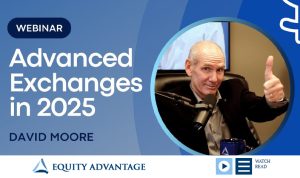This article summarizes their key points and expands on the practical considerations every investor should review before committing to a DST or a 721 conversion. The goal is to equip investors and advisors with clear, actionable guidance so the Exchange chosen aligns with long-term objectives.
Market update: why investors are pausing in 2025
Robert opens by noting the market is slow because many investors are in a wait and see mode. Two main forces are driving that caution:
- Interest rate dynamics – Fed guidance and recent rate moves influence borrowing costs and valuation expectations.
- Political and policy uncertainty – sudden changes in federal and state policy, including tax and regulatory proposals, make large portfolio moves feel riskier to many.
David adds that for many owners the central question is simple: what good is tax deferral if the replacement asset erodes in value? That perspective reframes Exchange decisions from purely tax-driven to outcome-driven. In short, preserve wealth first; defer tax second.
When tax deferral may not make sense
Tax deferral via a 1031 Exchange is powerful, but it is not always the correct move. David shared a real example: an investor inherited a property that has declined $300,000 over six years. The investor considered a 1031 Exchange into a condo near family, with the intention to convert it into a primary residence after a seasoning period. Questions to ask before executing that Exchange include:
- What gain was actually deferred into the current asset?
- What are the carrying costs of owning two properties during any seasoning period?
- What are the total tax and cashflow exposures compared with simply selling?
If the net effect is carrying two properties with increased exposure or negative cash flow, the Exchange may not be in the investor’s best interest. A facilitator who only executes an Exchange without assessing these variables is providing incomplete advice. David emphasizes the value of experienced advisers who will ask those hard questions before proceeding.
DSTs and 721 UPREITs explained – the mechanics
Davidwalk through the flow from a DST to a 721 UPREIT conversion and why Wall Street has embraced the 721 structure.
Delaware Statutory Trusts (DSTs)
- DSTs allow fractional ownership of institutional-grade real property. Investors own beneficial interests in a trust that holds the asset.
- DSTs preserve many of the tax benefits of direct property ownership, including depreciation and interest deductions, as long as the trust remains structured that way.
- DST investments are illiquid. Redemption is limited to management decisions and sponsor policies. They are typically offered through independent broker-dealers and sponsors that specialize in real estate offerings.
721 UPREITs
- A 721 Exchange converts ownership of real property into operating units of a privately held REIT, commonly called an UPREIT. Fractional DST ownership can be rolled into the UPREIT in exchange for REIT operating units.
- The UPREIT structure provides a quicker pathway for Wall Street distribution because operating units can later convert into shares of the REIT, a tradable security on a captive broker-dealer platform.
- However, investors should understand UPREITs are private, and redemption or sale is controlled by REIT management under specific caps and timelines. The liquidity is not the same as a publicly traded REIT.
Key differences, hidden risks, and misperceptions
Robert and David stress multiple pitfalls investors often miss when presented a 721 route as a solution.
Liquidity is constrained, not guaranteed
UPREIT conversion is often sold as creating liquidity. The reality is that an investor who converts into a privately held REIT has limited buyers. The principal buyer is REIT management, and redemption is subject to caps and timing. If many investors seek redemption at once, you enter a queue. This is not the same as selling shares on a public exchange.
Nature of the investment changes
When DST interests convert to operating units in a private REIT, the investor loses many direct-real-estate attributes. Depreciation and some tax benefits may change or be lost when those interests convert to REIT shares. Wall Street benefits from converting real property into securities that can be actively traded.
Property composition matters
Not all UPREIT portfolios are equal. Several large UPREITs carry legacy assets such as office or certain retail properties that face structural headwinds. Diversification is only beneficial when the underlying property types remain desirable in future markets. Investors should evaluate the quality and sector mix of the UPREIT portfolio before deciding.
When a 721 Exchange can be a suitable endgame
Both guests agree there are circumstances where a 721 is an appropriate solution:
- Terminal scenarios – investors who plan to exit direct ownership within a few years and prioritize simplified administration for spouses or heirs.
- Related party facilitation – in some family transactions a 721 conversion allows one party to take a tax-deferral route that enables another party to complete a 1031 Exchange under related party rules.
- Desire for market exposure – investors who want to move capital into securities or seek a path out of direct property management.
But the speakers repeat the same refrain: a 721 is an endgame. Do not enter it without full understanding of redemption limits, valuation mechanics, and the REIT sponsor’s track record.
Why Wall Street pushed 721 UPREITs into prominence
Robert explains that DSTs were historically distributed through independent broker-dealers. They were not Wall Street products. As DST volume grew, large broker-dealers sought a way to convert that real estate capital into products they could distribute on captive platforms. The 721 conversion is that lever. It does what Wall Street wants – moves capital from illiquid real assets into securities that can be marketed and traded. That is not inherently bad, but it is a material change for the investor and must be disclosed and understood.
DSTs as a tool for family-owned assets and transitions
A practical advantage of DSTs highlighted in the conversation is their ability to simplify family-held ownership structures. Two common approaches when an entity owns real estate with multiple family members are:
- Complete the Exchange at the entity level, purchase multiple DST properties, and later reassign membership interests so each family member owns a single DST asset separately.
- Use a swap-and-drop or drop-and-swap strategy to change ownership forms prior to or after the Exchange with careful tax counsel coordination.
Robert reports sponsors are typically cooperative with post-Exchange changes in ownership, and the administrative process is usually straightforward bookkeeping. This flexibility can be invaluable when heirs want to go their separate ways while preserving tax-deferred status.
Accredited investor rules, minimums, and access
A common frustration raised by both speakers is that many DST offerings require accredited investor status, often limiting participation to those with $1 million net worth excluding primary residence. That creates a paradox: minimum DST investments can be modest, sometimes $25,000, but regulatory rules often restrict access.
Why the discrepancy? The sponsors and regulators cite liquidity risk. DST investments are illiquid; if an investor needed quick access to funds the structure is not a fit. The accredited investor requirement aims to ensure participants understand the liquidity profile and the risk they are taking.
Practical tax reminders and Exchange mechanics
The hosts touch on several technical items investors must not forget:
- Holding periods and conversion to primary residence – conversion rules exist. If you acquire a replacement property via Exchange and later convert it to a primary residence, special timing rules govern Section 121 exclusion and can affect taxation.
- Related party transactions – a two-year hold requirement often applies when related parties exchange with each other. Consult tax counsel before structuring such deals.
- IRA-owned real estate – retirement accounts that own leveraged real estate can trigger unrelated business taxable income. Not every IRA real estate exit is tax-free in practice.
Policy, migration, and the investor environment
David and Robert extend the conversation beyond transactional minutiae into public policy and macro consequences. They note that escalating taxes, rent control, and regulatory burdens in some jurisdictions have encouraged migration of capital, business, and people to other states. The result is two-fold:
- Local property valuations and tax bases erode where policy discourages private ownership and investment.
- Investors consider alternative strategies such as DSTs, 721 conversions, or moving capital to more favorable markets to preserve wealth.
The takeaway is simple: public policy can materially affect investment outcomes. Ownership decisions must factor in jurisdictional risk as well as asset level risks.
How to approach the decision: practical checklist
Before agreeing to a DST purchase or a 721 conversion, run this checklist with your advisor and tax counsel:
- Clarify objectives – wealth preservation, income, legacy transfer, or liquidity.
- Quantify tax consequences – how much gain is deferred, what happens on conversion to a UPREIT, and your after-tax outcome.
- Review liquidity policies – redemption caps, timing, and the sponsor’s history with redemptions.
- Analyze underlying assets – sector mix, legacy properties, and vacancy or credit risk.
- Consider alternatives – installment sales, structured sales trusts, oil and gas interests for accredited investors, or remaining in direct ownership.
- Confirm service and disclosure – ensure the rep and sponsor explain the limitations and risks in writing.
Exchange with eyes wide open
David Moore and Robert Smith bring a clear, practitioner perspective: 1031 Exchange planning in 2025 requires both technical competence and situational judgment. DSTs and 721 UPREITs are valuable tools when used for the right investor and the right objective. They are not universal solutions.
Use these vehicles intentionally. Prioritize wealth preservation, understand how the nature of your investment changes when interests convert, and work with advisers who will ask the tough questions before facilitating an Exchange. Wall Street will offer routes that move capital into securities. Whether you take that route depends on your objective, timeline, and tolerance for the specific liquidity and valuation risks being assumed.
For follow up:
- Equity Advantage 1031 Exchange – David Moore, Exchange facilitation specialists since 1991
- Peregrine Private Capital – Robert Smith, phone 503-241-4949, website peregrineprivatecapital.com
Always consult your CPA and legal counsel before executing a 1031 Exchange or converting DST interests into a 721 UPREIT. These transactions are complex and highly fact specific.
The Guys With All The Answers…
 David and Thomas Moore, the co-founders of Equity Advantage & IRA Advantage
David and Thomas Moore, the co-founders of Equity Advantage & IRA Advantage
Whether working through a 1031 Exchange with Equity Advantage, acquiring real estate with an IRA through IRA Advantage or listing investment property through our Post 1031 property listing site, we are here to help Investors get where they want to be. Call them today! 503-635-1031.









